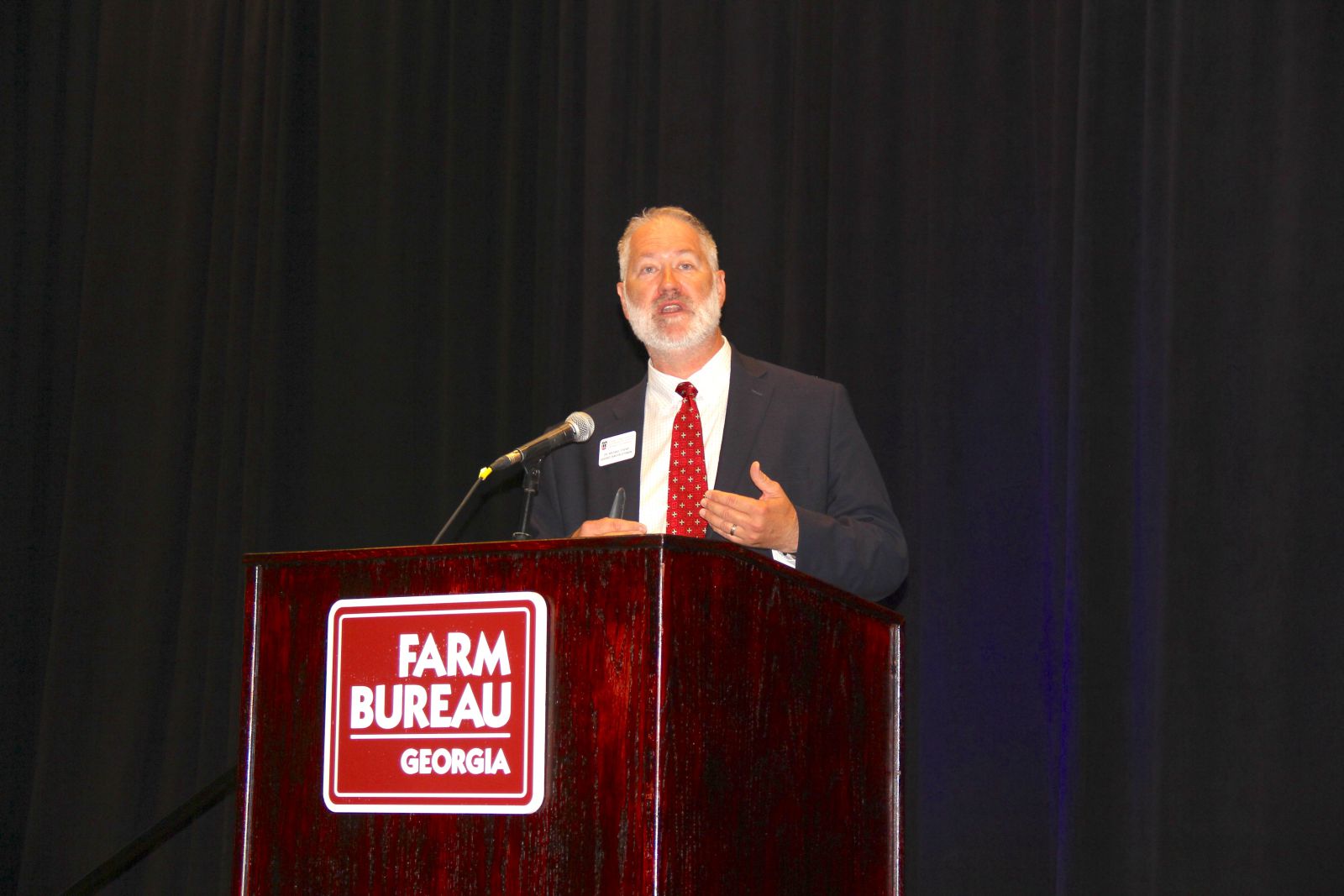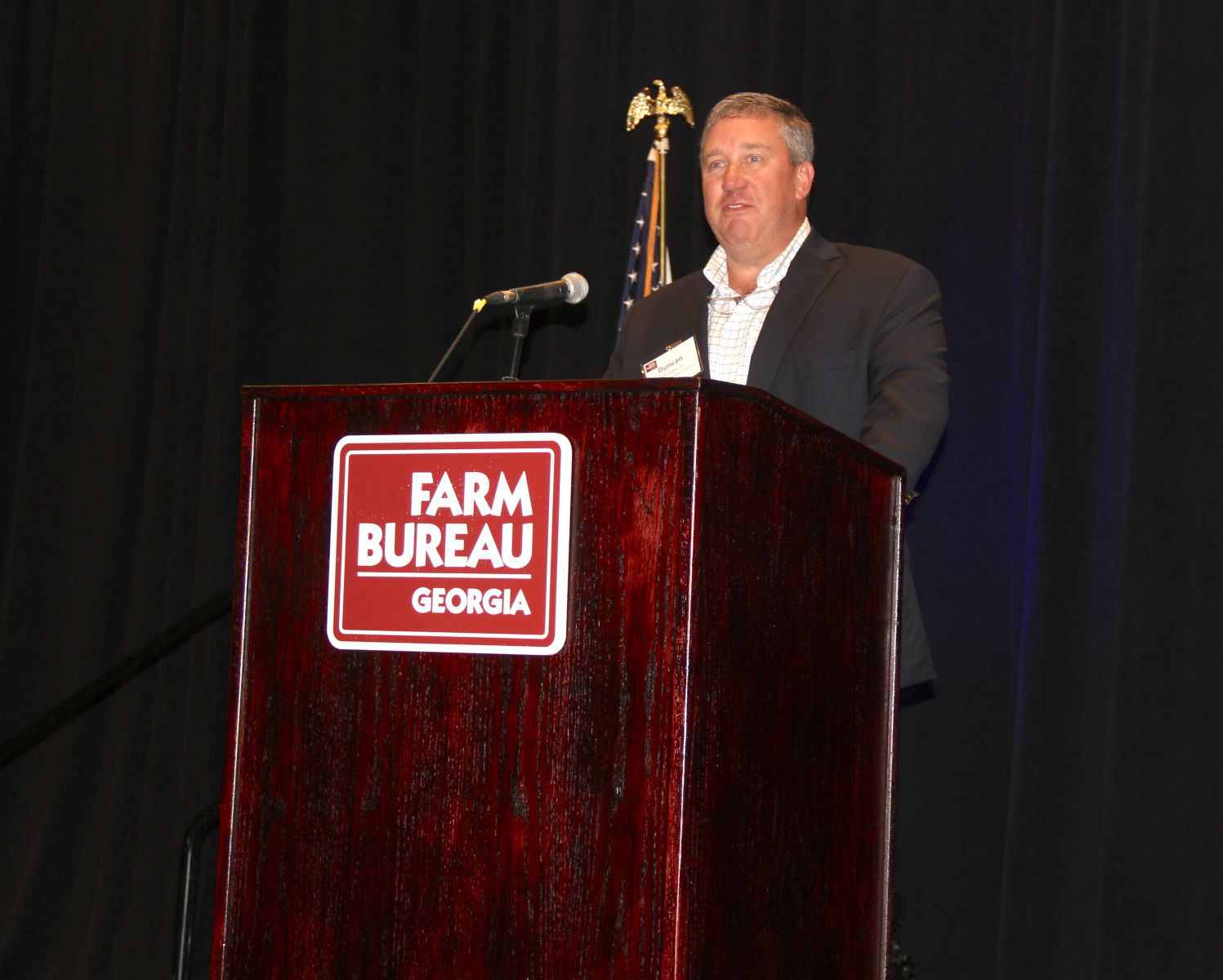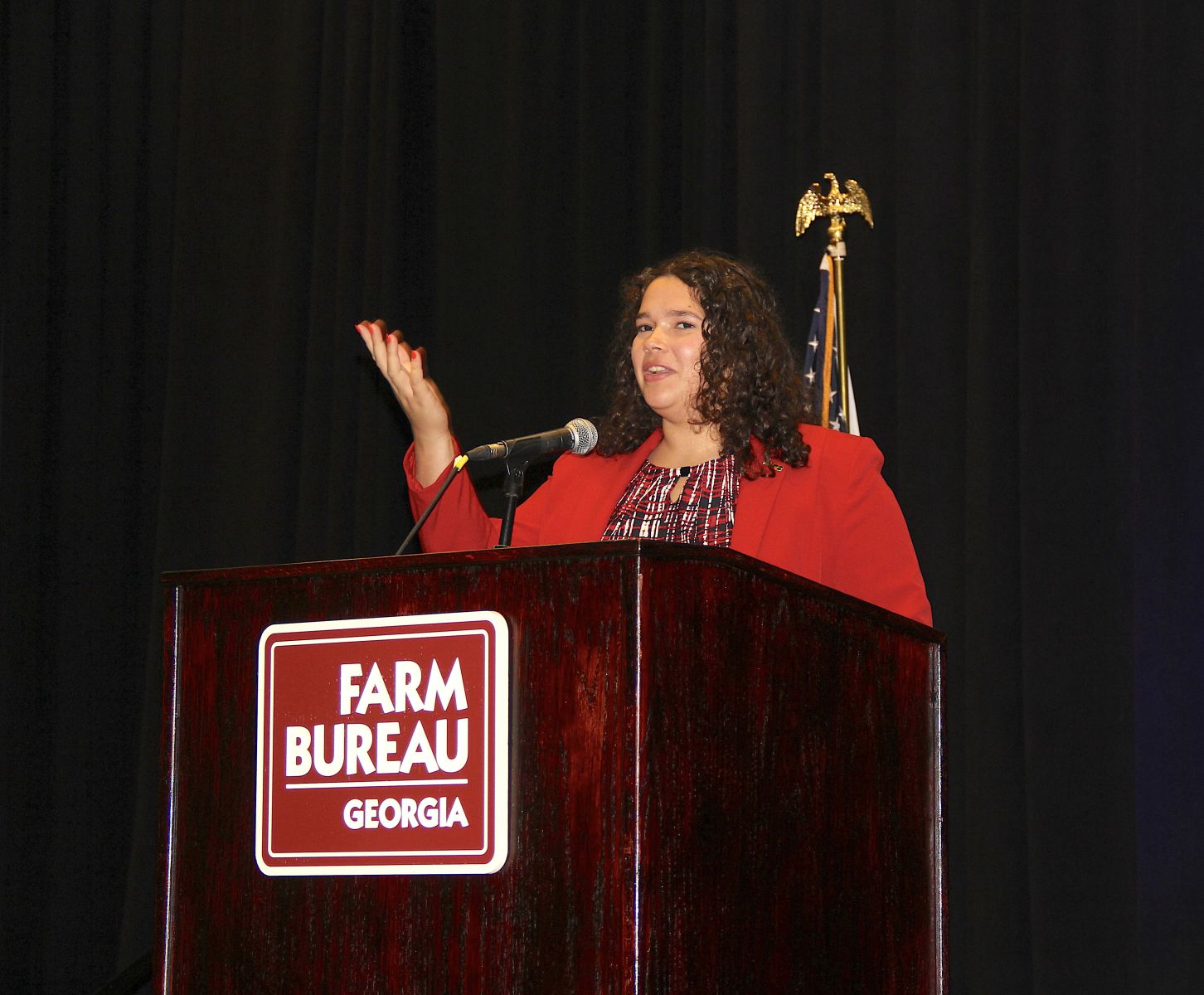Ag News
GFB Commodity Conference provides insights for members
Posted on Aug 20, 2025 at 15:22 PM
By Jay Stone & Jennifer Whittaker
The 2025 Georgia Farm Bureau (GFB) Commodity Conference, held Aug. 14 at the Classic Center in Athens, featured updates on key topics for the state’s farmers. Before breaking out into their meetings, GFB Commodity Advisory Committee members heard from representatives of the U.S. Environmental Protection Agency (EPA), UGA’s College of Agricultural & Environmental Sciences (CAES), UGA Cooperative Extension, the Georgia Department of Agriculture, the Georgia Farm Service Agency (FSA) and the American Farm Bureau Federation (AFBF). The conference also serves as the start of GFB's policy development process. The members of the organization's 20 commodity advisory committees reviewed the organization's policy on legislative issues pertaining to their commodities.
Bridgforth notes EPA actions concerning DEF, pesticides
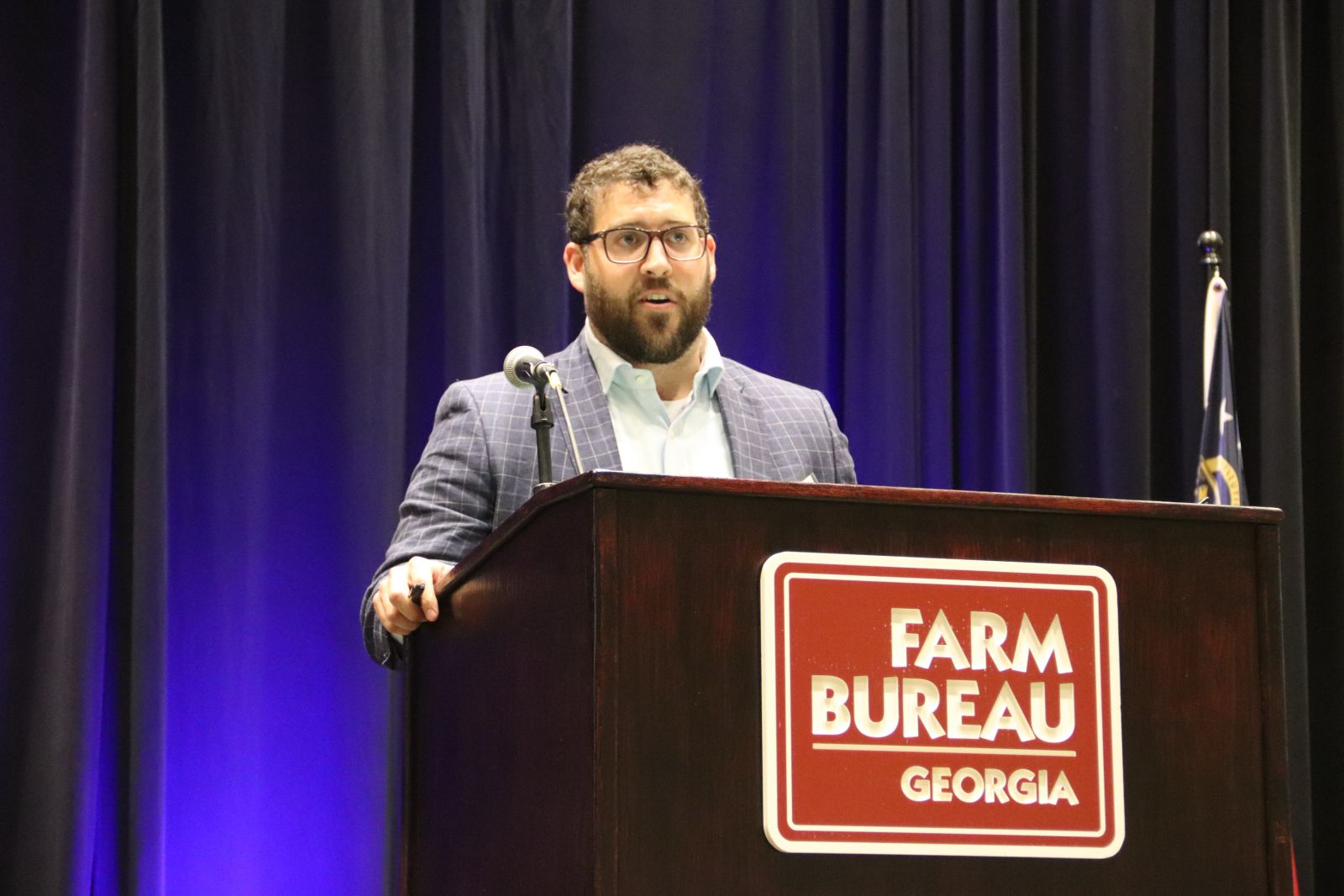
EPA Senior Advisor for Agriculture and Rural Affairs Turner Bridgforth, pictured above, highlighted the agency’s efforts to support U.S. farmers, including efforts to reduce regulatory burdens and administrative hurdles to help farmers be more productive and sustainable. Among these were reducing backlogs of pesticide registrations and producing a definition that provides regulatory certainty for farmers.
One major action the EPA is taking, Bridgforth noted, is addressing issues with diesel exhaust fluid (DEF) sensor faults that can disrupt farm equipment that uses diesel fuel. When the engine runs low on DEF, the equipment power is reduced or shuts down altogether; this can also happen due to faulty sensors. These power reductions and shutdowns interrupt farm operations and are particularly troublesome during planting and harvesting.
The EPA announced on Aug. 14 new guidance urging engine and equipment manufacturers to revise DEF system software in existing vehicles and equipment.
Bridgforth said that the EPA has learned that producers in other countries are not facing such requirements.
“Other countries allow their producers to have a tractor that doesn't have to have this requirement. That just brings an unfair competition to disadvantage to our producers.” Bridgforth said. “These modifications provide more flexibility and reliability without compromising air quality or emission reduction. EPA is calling on manufacturers to implement these DEF-related software updates quickly. We've streamlined the process. No separate EPA approvals will be required beyond our issued guidance letter.”
“American farmers are often bound by uncontrollable factors like weather and global market conditions. When conditions are right, it is critical that we have reliable equipment to plant seeds and harvest our crop. Our farmers have been disadvantaged by excessive regulations compared to our international competitors and the burden of additional inputs and derate issues when those systems fail," GFB President McCall said. "I applaud the EPA for this announcement, their attention to restoring reason in regulations on equipment only used for a portion of the year, and prioritizing the production of a safe, reliable food supply.”
Dean Place explores ways CAES supports new & existing students
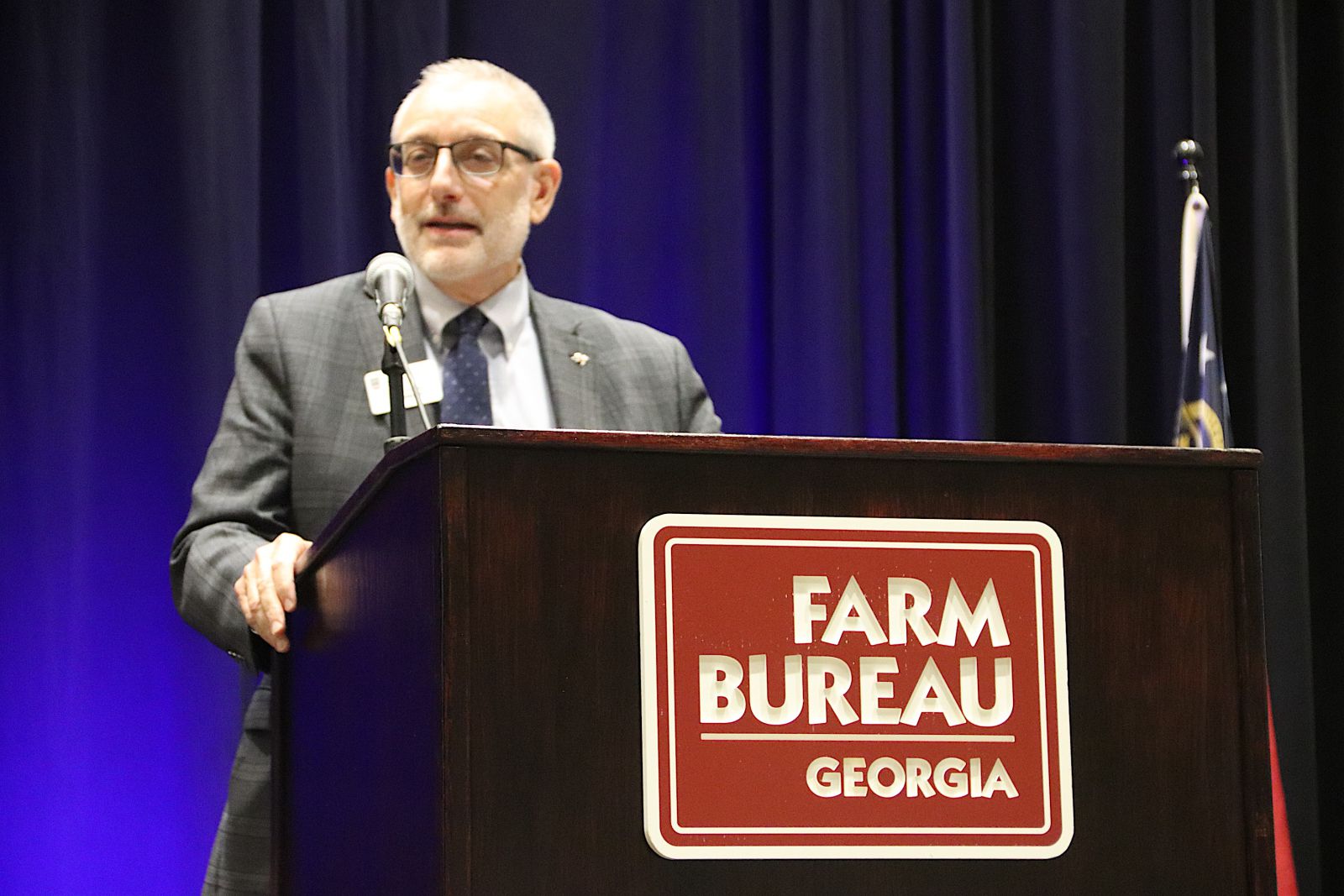
UGA CAES Dean Nick Place, pictured above, shared a number of key points with GFB members, pointing out ways the school is helping students gain entry to the university, the training CAES provides and how CAES is responding to public need by training students for essential jobs. This spring, CAES conferred 327 bachelor’s degrees, 4 certificates and 78 graduate degrees. CAES just welcomed 307 incoming first-year students, 108 transfer undergraduate students, and 180 graduate students.
Place noted growing student interest in animal biosciences, biological sciences and regenerative biosciences. Regenerative biosciences enrollment has increased by 222%. He said the Atlanta area is ranked one of the top five cities nationally for jobs in regenerative biosciences.
“There’s a lot of positions in agriculture and environmental sciences,” Place said. “We need to meet that need.”
One big hurdle is simply being accepted into UGA as a student.
“It’s hard to get in,” Place acknowledged.
For the 2025-26 school year, Place said, there were approximately 49,000 applicants for 6,500 student spots. CAES can help students, particularly those from rural areas, interested in agricultural careers by working with FFA and 4-H to provide opportunities to develop leadership skills and study habits.
“We need to work through FFA and 4-H to make sure students are prepared,” Place said. “We need to provide students with more opportunities to connect with industry.”
Part of that thrust is the Rural Scholars Program, which recognizes incoming, first-year students from Georgia's rural communities who have excelled academically, show strong leadership abilities, have a record of community service, and seek a degree in CAES. Applications through the Rural Scholars Program opened on Aug. 1 and the deadline for students to submit their application materials is 5 p.m. on Nov. 14. For information about the Rural Scholars Program, visit www.caes.uga.edu/students/scholarships/rural-scholars.html .
Place highlighted a new service through CAES, the Georgia Ag Impact Report, an online resource that provides commodity insights, county-by-county breakdowns and teaching materials. The Georgia Ag Impact report can be found at https://discover.caes.uga.edu/georgiaagimpact/index.html. This report has replaced the annual Ag Snapshots report CAES previously published.
UGA Extension is about people & trust & responding to ag problems, like cotton jassid
While speaking at the GFB Commodity Conference, UGA College of Agricultural & Environmental Sciences (CAES) Associate Dean for Extension Michael Toews, pictured above, gave an update on UGA Extension programs. Toews, whose last name rhymes with waves, has served as a researcher, instructor and Extension specialist since joining the UGA CAES Entomology Department in 2006.
Toews was co-director of the UGA Center for Invasive Species and Ecosystem Health before he began serving as assistant dean of the UGA Tifton campus in 2020. He began leading UGA Extension on April 1.
“When you visit with a county agent, they’re going to give you data based on research in your area,” Toews said. “We are all about Georgia farmers, families and communities. Extension is about people and trust.”
UGA Extension has 805 agents serving its 157 county offices that provide Extension programs for all of Georgia’s 159 counties, Toews said. State funding provides 39% of UGA Extension’s budget, followed by county support at 36%, grants at 18% and federal funds at 7%, Toews said.
“I can’t state enough how important county support for Cooperative Extension has been as federal funding has continued to decrease through the years,” Toews said. “We’ve been very fortunate that county leaders realize the value of the services Extension provides to local communities through 4-H, agriculture agents helping farmers, and family and consumer science agents working to improve the health of residents by educating them about nutrition. We do county-based programming and delivery that is specific to the needs of each county. Our strength is that we have people embedded in the communities we serve.”
Toews pointed out that UGA Extension has been able to quickly respond to the spread of cotton jassid insects this summer thanks to its network of county agriculture agents.
“There aren’t too many organizations that could have identified a new insect and tracked it so fast,” Toews said. “We first picked it up on cotton but are now seeing it on other crop hosts.”
UGA Extension entomologists & county agents are encouraging cotton producers to be on the lookout for the cotton jassid (two-spot cotton leafhopper). According to the August UGA Cotton Team Newsletter, the insect is believed to have been detected in 27 South Georgia counties since July.
If you find any of these insects or suspect an infestation in your field, contact your county agent for recommendations regarding insecticide treatments. The insect feeds on the lower surface of leaves, which leads to them turning yellow, red and then brown. These insects can remove all moisture from plants, leading to plants dying. Farmers should also watch their corn, soybean, peanut, okra, sunflower, eggplant, potato and pea crops.
“When you visit with a county agent, they’re going to give you data based on research in your area or closest to your area,” Toews said.
While agriculture is still the largest industry in Georgia, Toews said there is a need for Extension to educate urban audiences about where their food comes from.
“We need to educate consumers about nutrition and its role in preventing disease,” Toews said. To increase cotton prices, we need to increase demand. To do this, we need to educate consumers about the importance of buying cotton instead of synthetic fibers because cotton is more environmentally sustainable.”
Johnson, Georgia FSA executive director, outlines priorities for agency
While speaking at the GFB Commodity Conference, Georgia Farm Service Agency Executive Director Duncan Johnson, pictured above, gave an update on USDA and FSA programs.
“President Trump and Secretary of Agriculture Rollins are looking to reorganize the USDA to put farmers first,” Johnson said.
Johnson, who was appointed by the Trump administration to lead the Georgia FSA, outlined the three priorities he has set for the agency since taking office May 5. These priorities are:
1) Being Available. "I need to hear what your problems are," Johnson said. "What you like and what you don't like. I think my fresh perspective has allowed me to look at things in a different way. I’m making sure our people our available to you.”
2) Making sure communication flows from county FSA offices back to the state office and not just from the Georgia office to the county offices. "Information has always flowed downward and not a lot of information has flowed back to the state or federal offices, and we're changing that," Johnson said.
3) Improving program delivery. "When USDA announces programs, I want to make sure we get programs out quickly," Johnson said. “My goal is to have FSA bank accounts empty because we have distributed the money to its intended recipients. Our middle name is Service, and we’re going to start acting like it.”
Johnson reminded farmers at the conference that signup for Stage 1 of the Supplemental Disaster Relief Program (SDRP) for producers with indemnified losses due to natural disasters in 2023 or 2024 began July 10. To expedite the implementation of SDRP, USDA mailed prefilled applications to producers that who had eligible crop losses under crop insurance or the Noninsured Crop Disaster Assistance Program for 2023 or 2024. If you think you should have received an application and did not, contact your local USDA FSA office. To apply for SDRP, producers must submit the FSA-526, Supplemental Disaster Relief Program (SDRP) Stage One Application, in addition to having other forms on file with FSA.
As of Aug. 19, USDA had approved 4,624 applications from Georgia producers and disbursed $89.56 million to them.
SDRP Stage Two signups for eligible shallow or uncovered losses are expected to begin around Sept. 29.
Eligible losses for SDRP must be the result of natural disasters occurring in 2023 and/or 2024. These disasters include wildfires, hurricanes, floods, excessive heat, tornadoes, winter storms, freeze, smoke exposure, excessive moisture, qualifying drought, and related conditions.
To qualify for drought-related losses, the loss must have occurred in a county rated by the U.S. Drought Monitor as having a D2 (severe drought) for eight consecutive weeks, D3 (extreme drought), or greater intensity level during the applicable calendar year.
Visit https://www.fsa.usda.gov/resources/programs/supplemental-disaster-relief-program-sdrp for more information about the SDRP. The $16 billion USDA is distributing nationwide to farmers and ranchers through the SDRP is part of the $21 billion Congress allocated for disaster relief assistance to farmers and ranchers in the American Relief Act of 2025 passed last December.
Signup for the USDA Emergency Commodity Assistance Program (ECAP) ended Aug. 15. Congress allocated $10 billion to this program in the American Relief Act of 2025 passed last December. This one-time economic assistance payment was for producers of eligible commodities in the 2024 crop year. Eligible commodities include all those covered by Title I of the farm bill, excluding temperate rice japonica. USDA FSA sent applications to eligible producers.
Johnson is responsible for overseeing the delivery of FSA programs to Georgia farmers, ranchers and forest landowners. These commodity, conservation, credit, and disaster assistance programs ensure a safe, affordable, abundant and nutritious food, fiber, and fuel supply for all Americans.
FSA implements agricultural policy, administers credit and loan programs, and manages conservation, commodity, disaster recovery and marketing programs through a national network of state and county offices and locally elected county committees. For more information, visit www.fsa.usda.gov .
Johnson most recently served as president of Johnson Consulting and Mediation in Augusta before being. Before that he spent 28 years as a new car dealer in a generational family business.
He has served 11 years on the Georgia Department of Natural Resources Board and previously served as a trustee for Leadership Georgia and the Georgia Board of Physicians Workforce. He is a director of Camp Lakeside Pediatrics Disabilities Camp.
Duncan and his wife, Kaci, live in Augusta and have two adult children. In his spare time, he enjoys bird hunting and fishing.
Harper discusses GDA role in support of state’s farmers
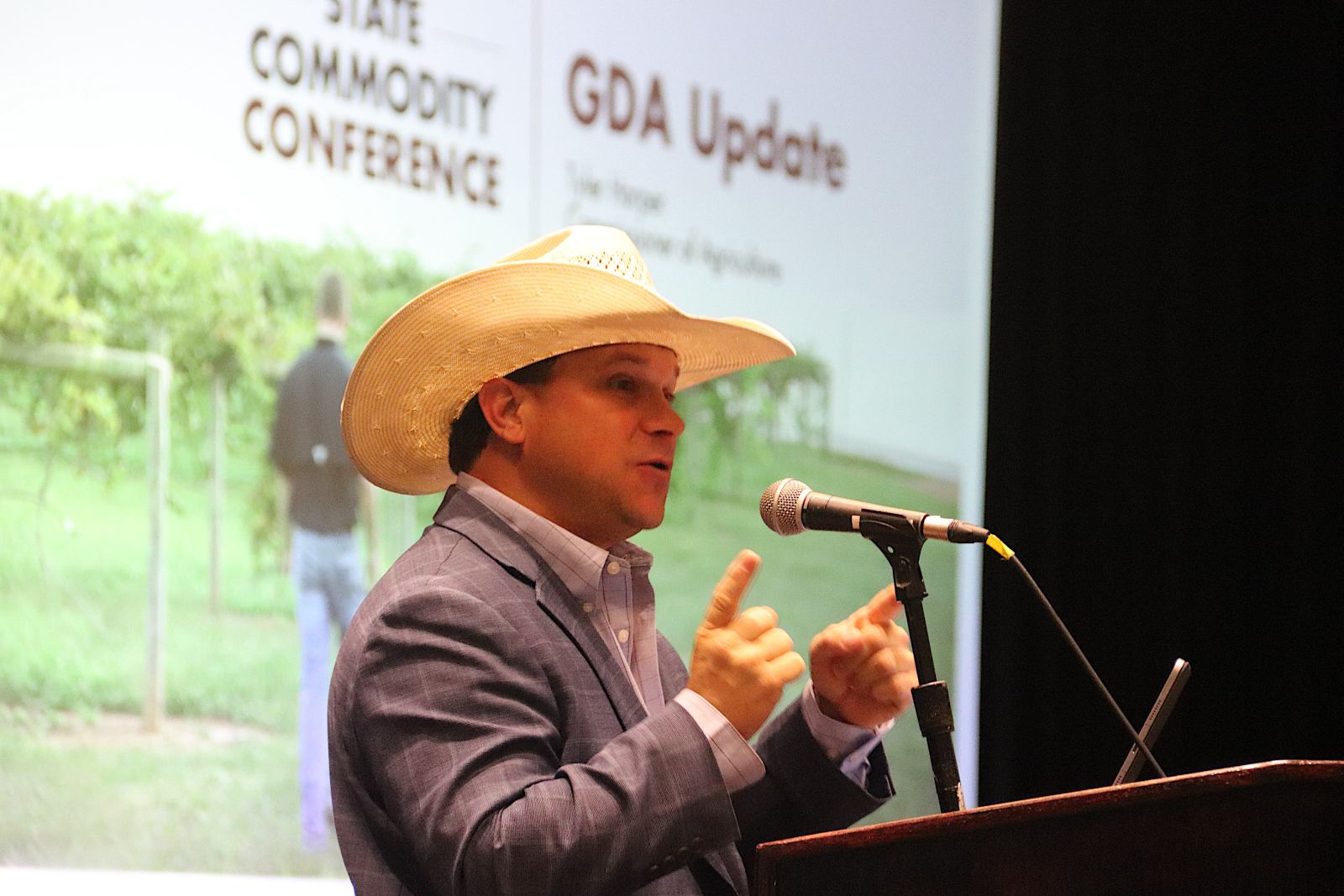
Georgia Agriculture Commissioner Tyler Harper, pictured above, reviewed the Georgia Department of Agriculture’s (GDA) investments in infrastructure and capabilities, with upgrades to the Atlanta Farmer’s Market, the Tifton Seed Lab and emergency response systems. Harper encouraged GFB’s farmer members to engage with policymakers.
“That's what you're doing today obviously at the commodity conference and helping setting that policy and helping guide that policy for our state’s agriculture,” Harper said.
The GDA seed lab in Tifton, which focuses on germination and certifying viability of seeds for the state’s crops, also has verifying purity as one of its functions. The lab now has two employees certified to provide purity analysis.
“I believe there are only about a hundred people in the entire country that are certified to do purity. So, we have two of them working for us at the Department of Agriculture, and I think that bodes well for our staff and our team and the services that we can provide the citizens across the state,” Harper said.
Back-up generators are being installed at the lab in Tifton, and a new lab facility with food safety and dairy functions is being planned for the Atlanta area as a contingency in case the Tifton lab becomes unavailable.
Harper gave an update on developments at the Atlanta Farmer’s Market, noting that the Georgia legislature allotted approximately $150 million for improvements at the market, which will ultimately mean expanded market access for the state’s farmers.
“We're able to provide that service across the southeast because for all practical purposes, the Atlanta Farmers Market is the produce terminal for the southeastern United States, and it's very important that we invest in that,” Harper said.
Cattle prices are bright spot for U.S. ag economy
American Farm Bureau Associate Economist Samantha Ayoub, pictured above, provided an overview of Georgia’s ag economy. She said cattle prices are one of the bright spots for producers as production costs for row crops are outstripping returns for row crops.
“Annual production costs for nine principal row crops including corn, soybeans, wheat, sorghum, cotton, rice, peanuts, barley and oats have increased by $40 billion or 30 percent since the 2018 farm bill was passed," Ayoub said. "Annual returns have decreased $57 billion or 22 percent since 2022.”
Based on USDA economic forecast numbers released in February and American Farm Bureau calculations, Ayoub said property taxes & fees have increased 6% in the past year, seed costs have increased 4% this year over 2024, marketing, storage & transportation costs have increased 4% in the past year, electricity expenses have increased 2%, and repair & maintenance costs have increased 1%.
Based on USDA economic forecast numbers released in February and American Farm Bureau calculations, Ayoub said U.S. cattle and calf sales are expected to remain the same in 2025 as they did in 2024 at about $108 billion. Sale receipts for dairy products and milk are expected to reach $52.1 billion this year a 3% increase above $50.8 billion in 2024. Sale receipts for broilers (chickens grown for meat) in 2025 are expected to hit about $46.3 billion, a 3% rise over $44.9 billion in 2024. Hogs are expected to have $30.4 billion in sales receipts this year, a 5% increase over the $28.9 billion sold last year. Eggs are expected to have lower sales receipts this year at $25.7 billion, a 2% decrease from $26.3 billion in 2024.
Ayoub said broiler meat is selling for an average of $1.34/lb this year, up from $1.29/lb last year. There is both increased production and higher demand for poultry meat.
Tight supplies of eggs, due to avian flu having decimated entire flocks of hens that lay table eggs earlier this year, have driven the average price of a dozen eggs up to $4.15, Ayoub said.
USDA’s July Cattle Inventory Report, reinstated after its 2024 cancellation, shows there were 94.2 million head of cattle and calves, down 1% from 95.4 million on July 1, 2023. The 2025 calf crop is estimated at 33.1 million head, down 1% from the 2024 January Cattle Inventory Report, and the smallest on record. Beef cows were estimated at 28.7 million head, also down 1% from 2023 and a record low since data started being collected in 1973.
“Don’t expect herds to grow in the next year because heifers are being placed in feedlots,” Ayoub said.
According to the 2025 AFBF July 4th Cookout Price Survey conducted in June by volunteer shoppers across the United States, two pounds of ground beef cost $13.33, an increase of over 50 cents from last year.
The USDA is forecasting the 2025 U.S. net farm income will be $138 without including federal support payments and $180 including $42 billion in federal support payments. The USDA 2024 forecast for U.S. net farm income was $130 without including federal support payments and $139 billion with federal support payments. Congress allocated more money for federal support in 2025 due to the severity of natural disasters farmers experienced in 2023 and 2024 and more economic assistance payments for 2025 because of lower crop prices and higher production prices.
- Categories:
- Tags:
